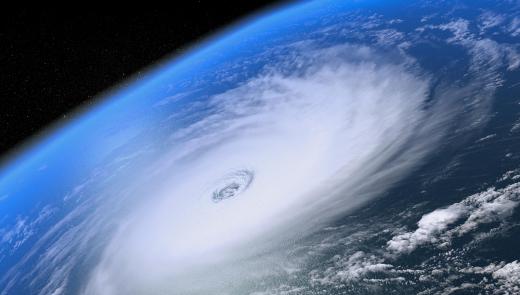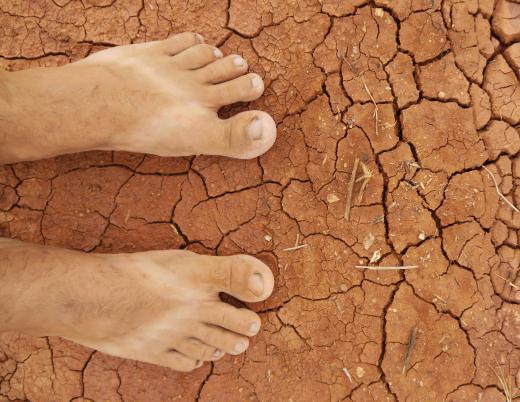What are Some Predictions for Future Climate Change?
 Jessica Ellis
Jessica Ellis
With considerable attention focused on the effects of global warming in the 21st century, many people are interested in predictions of future climate change. Although many, if not most, scientists agree that the current trend of global warming will affect the climate, predictions are far from uniform in nature. In fact, the scientific predictions for future climate change vary widely in all directions, leaving a confused and concerned public unsure of what to expect in the coming years.
It is natural to assume that a warming trend would result in warmer temperatures around the world, but the matter is far from that simple. Indeed, most climate change scientists offer varying future climate change models based on exactly how much warmer the Earth’s temperature becomes by the year 2100 and beyond. Most predicting climate models are based on the current level of carbon dioxide in the atmosphere and take into account varying degrees of decreasing CO2 levels over the 21st century. Although almost all widely accepted models suggest that the overall temperature will rise, the amount and resulting effects vary greatly between scenarios.

According to the average of many future climate change predictions made at the dawn of the 21st century, the global temperature rise will be 3 degrees Celsius (5.4 degrees Fahrenheit) by 2100. Although a 3 degree change may sound minor, scientists insist that the resultant effects could be catastrophic for both humans and the planet as a whole. Loss of polar ice, massive flooding, increased desert climate, and severe storm increases are all commonly invoked outcomes of this seemingly small change.

Assuming that the average increase is correct, over the 21st century there is likely to be a severe increase in polar ice melt. This melting may lead to an increased sea level, inundating coastal regions around the world and potentially resulting in the loss of current coastal cities and inhabited islands. The sea is also expected to warm dramatically, causing devastation to marine wildlife and greatly increasing the production of hurricanes, typhoons, and severe marine storms.

Another devastating effect of many future climate change models is the spread of deserts around the world. Desertification is the result of a loss of nutrients in the topsoil of land, causing once-fertile areas to become unusable for agriculture. Not only will severe desertification destroy many temperate and tropical ecosystems, it may also seriously decrease human food supply as traditionally agricultural land becomes a wasteland.
Future climate change predictions are justifiably frightening, and seem to predict a long and difficult future ahead of the human race. Most scientists suggest that the best way to avoid or lessen many of the painful consequences of global warming is to immediately reduce carbon dioxide emissions dramatically. Switching to alternative, clean burning fuels, investing in alternative energy technology, and taking part in global efforts to educate people about sustainable practices may help prevent numerous disasters in the future. According to some experts, the best response to future climate change is preparation and prevention. Although many scientists agree that global warming effects are unavoidable, many experts believe that slowing their progression and lessening the impact to the planet need to become major priorities of both governments and world citizens alike.
AS FEATURED ON:
AS FEATURED ON:













Discussion Comments
@ Wizzod- I think your idea is a good idea, but I think that we should also study any idea like this very carefully. Blind ingenuity was what led to our current situation where civilization built itself on a limited resource that is crucial for its survival. To solve the issues of human caused global warming and climate change we need to make sure we are not causing more problems in the process. I would be interested to see an environmental impact study done on your idea.
@ Wizzod- That sounds very interesting and all, but I am sure that this would cause some unforeseen events that would adversely affect many species and subsistence fishers around the world. The first problem is the difference in salinity of the two bodies of water. This is a problem in other areas where mitigation plans are being worked on to join two different bodies of water (the red sea and the dead sea in the red-dead canal project: Palestinians, Jordanians, and Israelis).
The other obvious problem would be the need to drill below and through the territorial waters and landmasses of other countries (Mexico, etc). You would be hard pressed to get support for a project of this magnitude unless an international deal was worked out which benefited all countries involved.
Finally, you would have the problem of operational efficiency. You would either have a number of separate entities to oversee each different aspect of the project, or a single organization that could handle the engineering tasks, maintenance tasks, fish farming, pollution monitoring, and the new ecological balance of the oceans; a political and engineering hydra so to speak. The causes of climate change are numerous, so it is very unlikely there will be a single engineering solution to the problem.
I have been studying and predicting the current changes in climate for several years now.
In 2004 I predicted that we had until 2050 +-10 years before the sea level rose 1-5 meters.
At the time, it was 1/2 of the most commonly accepted predictions. This is the timetable produced in 2009 October by British climatologists.
As more data came in, it became obvious that the rate of acceleration was much higher. News stories repeatedly reported new data with the addendum that the climate scientists were surprised by the high rate of change they were observing.
The new data only confirmed my predictions, while forcing me to reduce my timetable further.
By 2007, my projections indicated that we would see a 1-5 meter rise between 2012-2028.
New data from the summer of 2009 has forced me to increase the sea level rise while maintaining the timetable. I now expect up to 10 meters of sea level rise, in the same time period. The most likely timing is 1-10 meters between 2012 and 2018.
The factors which go into the melt rate which determines the sea level rise, are all positive feedback (what happens when you get a microphone near the speaker it's feeding.)
This means that the change is non-linear, and an increase of .1 meter one year may easily be followed by 1 meter the next and up to 10 the year after.
In searching for a solution, i found a few which could act very rapidly to slow the change or even reverse it temporarily, but the are not politically feasible and have nasty side effects.
I now have a potential solution which:
1) Has geological data supporting the fact that it should work.
2)Requires only about US$10 billion.
3) Can be built in under 10 years.
4) Will, upon completion have immediate affect on the local climate, and global effects with in months.
5) Requires no international cooperation.
6) Will generate clean electrical power and food as byproducts.
7) Uses existing well known engineering practices.
This project, The Panama Pipe Energy Project, would consist of a large tunnel/pipe running from the Caribbean surface in to the Pacific depths.
It would have a tidal dam on either end, and generators at to produce power. The water would then flow through fish farms (the Western Caribbean has few nutrients, the Pacific depths have lots of nutrients.
The water is driven by the 3-6 meter difference in tidal height between Caribbean and Pacific, as well as the20cm sea level difference.
The project affects the climate by cooling the Western Caribbean, restarting a conveyor current which existed 3 million years ago, when our climate was much, much more stable than any time since.
This current runs on the cooled water dropping in the West and flowing east along the bottom. This in turn brings in cooler water from the Atlantic, cooling the Caribbean surface.
Since as of October 2009 the EU estimates that the developing countries will need Euro 138 billion each year to fight climate change, the cost is minuscule--and can be paid off with earnings from electrical generation and fish sales.
Post your comments